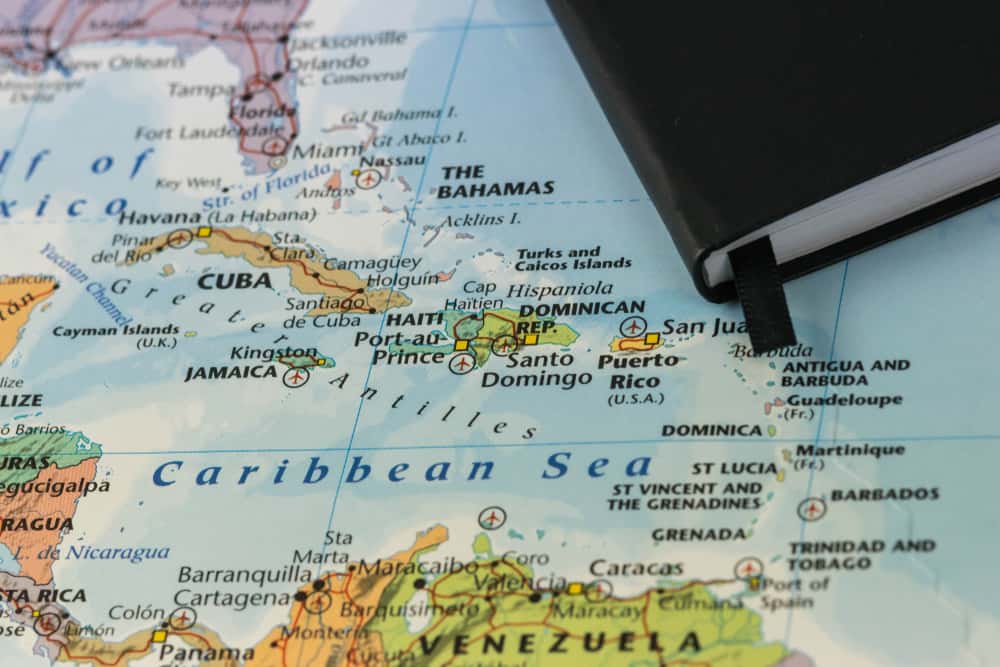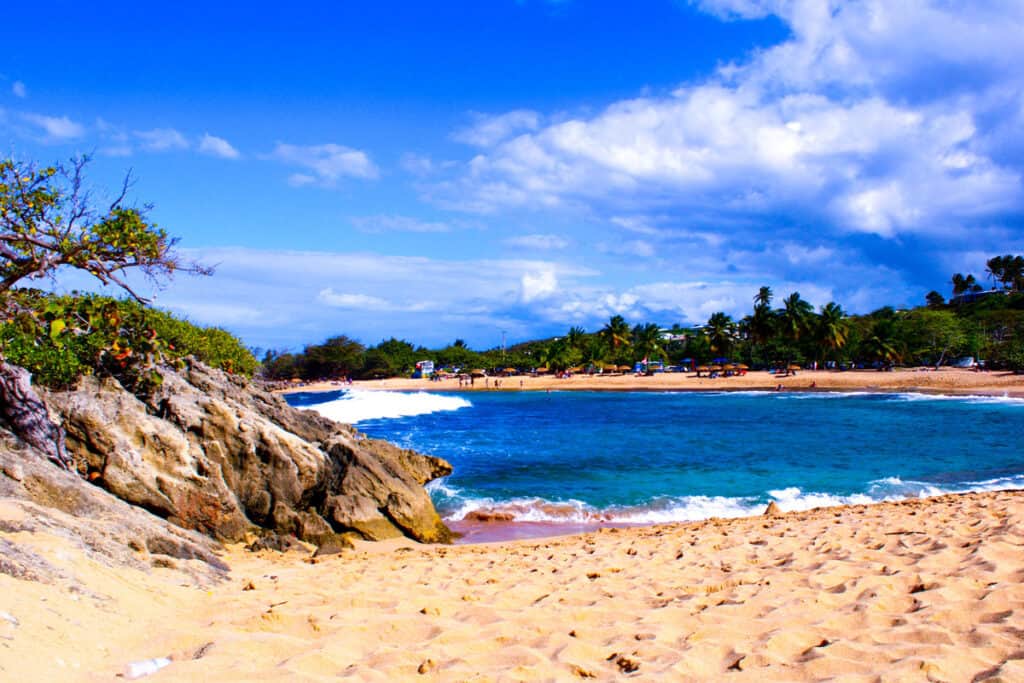Puerto Rico is a unique place with rich culture. It is a very popular place to visit, especially during warm summers. The warm beaches are clear and clean and everywhere. Puerto Rico is also home to El Yunque, a tropical rain forest with waterfalls and home to many animals like the coqui. The island also has many mountains and rivers that flow through them. Puerto Rico isn’t just stunning, but is also known for its many types of music.
Puerto Rico is a territory of the United States with a form of citizenship. The flag is easily identifiable but is sometimes confused with the Cuban flag which has the same design with the colors reversed. The flag of Puerto Rico has changed a few times and has a lot of meaning. Are you ready to discover the history, meaning, and symbolism behind Puerto Rico’s flag? Keep reading to learn more.
Where Is Puerto Rico?
Puerto Rico is a U.S. territory in the Caribbean. It consists of one main island and other smaller ones including Vieques and Culebra. Puerto Rico is situated between the Caribbean Sea and the North Atlantic Ocean. It is the third-largest island in the U.S and has a surface area of 3,515 square miles.

Puerto Rico is a U.S territory in the Caribbean.
© wael alreweie/Shutterstock.com
Where Is Puerto Rico Located on a Map?
Puerto Rico is around 1,000 miles southeast of Miami, Florida. The island is east of Dominican Republic and west of the British Virgin Islands and the U.S. Virgin Islands.
The History of Puerto Rico
Puerto Rico has a long history which starts with the Ortoiroid culture from the Orinoco region in South America. Experts believe they settled on the island over 4,000 years ago. However, by the time Christopher Columbus landed in Puerto Rico, the dominant population was Tainos. The Taino people are the descendants of Arawak that settled in the Caribbean. They traveled to the island and called it home. The Taino population were hunters and gatherers and called the island Borinquén and themselves boricuas. Puerto Ricans today still refer to themselves as boricuas.
Spanish Rule
On November 19, 1493, Christopher Columbus landed in Puerto Rico and declared it San Juan Bautista. On August 8, 1508, Ponce De Leon founded the first European colony on the island. Soon after, the Spanish settled in a nearby islet on the coast, named Puerto Rico. This was later flipped as the island is called Puerto Rico and the islet, also the current capital of the Commonwealth, is San Juan. The Tainos were enslaved in the first encomienda system.
In 1511, the Tainos had enough and rebelled against the Spanish. Agüeybaná II planned the revolt and Urayoán ordered his warriors to drown Diego Salcedo, a Spanish soldier. They tested his death to see if they were really immortal and watched over his dead body for three days. However, the revolt did not last long as Ponce De Leon’s soldiers were too powerful. Sadly, the Taino population declined rapidly because of illnesses brought by the Spanish, famine, and suicide. The Tainos also fled to the mountains and mixed with the Spaniards and Africans. Spanish rule lasted until 1898.
United States Rule
After the Spanish-American rule and the ratification of the Treaty of Paris of 1898, Puerto Rico was placed under the United State’s military control. Things changed quickly, including the Puerto Rican peso which was switched to the United States dollar. The Foraker Act of 1900 stopped military rule and created the Supreme Court of Puerto Rico. Tobacco, sugar, cigar, and coffee were heavily produced and young children and women worked in the factories and fields.

After the Spanish-American rule and the ratification of the Treaty of Paris of 1898, Puerto Rico was placed under the United State’s military control.
©Maridav/Shutterstock.com
During the early 1900s, the island was politically divided and still is today. Some people want statehood, while others want to remain with their status or declare independence. Things changed a lot for the people on the island when the Jones Act of 1917 was passed. This act, signed into law by President Woodrow Wilson gave the citizens of Puerto Rico a form of citizenship, but forced goods to come through the U.S. before the island, making products more expensive.
Unrest and Strict Rule
By the 1930s, there was a lot of unrest leading to massacres and many arrests. For example, on March 21, 1937, a peaceful march was held in Puerto Rico to commemorate the ending of slavery in Puerto Rico in 1873. The US-appointed colonial Governor of Puerto Rico, General Blanton Winship ordered the police to open fire at the crowd, resulting in the death of 20 people and the injuries of 100-200 more. A little over a year later, the same general participated in a march celebrating the United States’ invasion of Puerto Rico in Ponce.
From 1948 to 1952, the U.S. became very strict with Puerto Rico, trying to Americanize the territory. It was a felony to wave Puerto Rico’s flag. You were only permitted to own the flag of the United States. It was also illegal to sing a patriotic song.
Modern History
Despite the United States attempts at erasing the identity and culture of Puerto Ricans, the food, language, and culture remain. However, Puerto Rico is in a debt crisis with millions of people leaving the island. More Puerto Ricans live outside of the island than those who have remained. Tourism is a huge part of Puerto Rico’s economy bringing in 4 million visitors a year. Puerto Rico has also experienced extreme hurricanes and earthquakes which have resulted in the loss of power, infrastructure, and lives. On September 20, 2017, Hurricane Maria left millions of people without light and food for months and took the lives of thousands of people.

Tourism is a huge part of Puerto Rico’s economy bringing in 4 million visitors a year.
©iStock.com/Alvin Rodriguez Caraballo
History of Puerto Rico’s Flag
Puerto Rico has had many flags starting with the first one brought by Christopher Columbus. He used the royal flag which had a green cross in the middle. The flag was white and on the left side of the cross was a green ‘f’ with a golden open crown. On the right side of the cross, also with a crown, was a ‘y’. When the Spanish took the island as a colony, they used the Spanish flag.
The Lares revolutionary flag of 1868 was born out of the independence movement. It was inspired by the Dominican Republic as leaders at the time pushed for the unity of the three Caribbean islands. The flag is divided by a white cross in the middle. The two lower corners are red, while the two upper corners are light blue. On the left upper corner is a five-pointed white star.
The current flag was designed in 1892 or 1895. The current flag is based on Cuba’s flag, but with a blue triangle with a white star in the center and 5 stripes alternating red and white. The first theory is that Francisco Gonzalo Marín designed the flag in New York and presented it to the Puerto Rican Revolutionary Committee. The second theory states that Antonio Vélez Alvarado created the flag in his apartment when he was staring at the Cuban flag. This has been disputed by scholar Armando Martí. And who sewed the flag? No one knows for sure! Maria Manuela Besosa, the daughter of the Puerto Rican Revolutionary Committee member Manuel Besosa claims she sewed the flag, which has pushed others to believe her father designed it.
Meaning and Symbolism of Puerto Rico’s Flag
Puerto Rico’s flag means a lot. The design inspired the flag of Lares which was raised with pride during marches and protests against Spain and the United States. The current flag has three colors. Although some flags use dark blue, light blue is the official color. The blue represents the sky and the ocean surrounding the island. The three red stripes symbolize blood from past brave warriors. Next, the two white stripes represent victory and peace, which they should attain after independence. The iconic white star is the island. Finally, the triangle, since it has three sides, represents the three branches of government. Next time you take a trip to Puerto Rico, admire the flag! It’s now flown everywhere with pride when it once was illegal to do so.
The photo featured at the top of this post is © Artgraphixel/Shutterstock.com
Thank you for reading! Have some feedback for us? Contact the AZ Animals editorial team.






